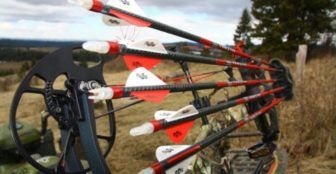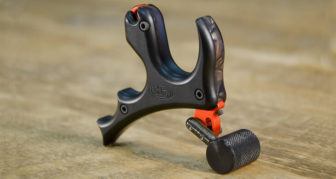4 Types of Compound Bows: Single, Dual, Hybrid, Binary Cam
Whether you’re a hobby or a competitive archer, a compound bow will elevate your shooting ability. They are hailed for their precision and the fact that they have power cams that make shooting easier.
However, before purchasing one you need to be familiar with the different types of compound bows and their various pros and cons.
Types of Compound Bows
1. Single Cam
Photo: abbeyarchery.com.au
A single cam bow is the simplest of the compound bows. It features one cam that is used to flex the bow and make firing an arrow easier. It is suitable for beginners because is not overly complicated in use and maintenance as the other compound bow counterparts.
Moreover, having fewer moving parts compared to the other compound bows, makes this bow quitter in operation.
The bow features one power cam that is located on the lower limb and to balance it out, it has an idler wheel on the upper limb. These wheels enhance the bow’s accuracy and smoothness when firing, unlike in the ordinary bows.
The main issue with this bow lies in it having a power wheel that turns and an idler wheel. This creates unequal pressure on the arrow’s nock, interfering with nock travel. It may then interfere with accuracy as compared to other compound bows.
Pros:
Cons:
2. Twin/Dual Cam
Photo: Bear Archery
This dual cam compound bow was meant to correct the nock travel issues that were presented by the single cam bow; due to the lack of wheel balance that affects the pressure on the nock.
It has two cams of equal ability and thus produces more draw weight and better arrow propulsion.
More experienced archers who want a better draw prefer this type of bow because it is not overly complicated like the binary and hybrid ones, yet, it is able to perform much better than the single cam bow.
The two cams work in synchrony with one another, in one configuration. They are similar in shape (circular or elliptical) and all other features. This is important to ensure a harmonious balance in pressure on the arrow’s nock and enhance the drawing power and arrow speed.
Even with the similarity, the two cams work independently, and therein lies the risk of one rotating faster than the other thus creating a synchronization problem.
Further, this may cause the bowstring to stretch irregularly and consequently cause an imbalance between the upper and lower limb. As such, sturdier strings are required to reduce this effect.
The main downside of having too many moving parts in this bow present in the noise it produces during operation.
Pros:
Cons:
3. Hybrid Cam
Photo: Bear Archery
This compound bow is an improvement on the twin cam bow in that it is made to resolve the synchronization mishaps often presented by the latter. It features two cams but with a different setup.
The cam on the lower limb is the power cam and it is connected by cable to the upper limb. Meanwhile, the control cam located on the upper limb is connected to the power cam rather than directly to the lower limb.
This setup, therefore, ensures that the upper control cam follows the movements of the power cam. This dependency creates more synchrony and thus resolves the problem of one cam moving faster than the other which is seen in twin-cam bows.
Automatic synchronization is achieved with this set up and tuning the bow is easier and the overall required maintenance is lower.
It also means that the pressure on the arrow nock is balanced, hence there are limited nock travel problems. Consequently, arrow accuracy and speed are enhanced.
Pros:
Cons:
4. Binary Cam
Photo: pngegg.com
The binary cam compound bow is the most advanced in bow technology. It resolves the issues of the dual and the hybrid bows and improves on them. Most experienced archers especially those in competitive archery prefer this type of compound bow.
Unlike the hybrid bow that has one power cam and one control cam, this binary technology features two dependent power cams that are in synchrony with one another.
The upper limb cam is connected directly by cable to the lower limb cam while the lower limb power cam is connected to the upper limb cam. This connection creates a dependency between the two cams and their movements become uniform.
Having two power cams generates more draw weight and power which positively impacts the arrow speed, making its velocity very high. They are automatically balancing and this reduces the nock travel issues.
Even though the set up on this bow increases precision, it is complex and requires frequent maintenance and tuning. Other issues associated with this bow pertain to patenting and this has made manufacturers market it as a hybrid bow to avoid legal issues.
Pros:
Cons:
Conclusion
In conclusion, there are single cam bows with only one power cam and an idler wheel while dual cam bows feature two similar cams. The hybrid cam compound bow improves on the dual-cam design and has one power cam and one control cam on the upper limb.
Binary cam compound bows are the most complex and most powerful, seeing that they have two power cams that are directly connected to provide more synchrony to the movements. The main maintenance practice for all these bows consists of tuning to keep them well balanced.
Reference
- A Primer on the Compound Bow - The Art of Manliness

